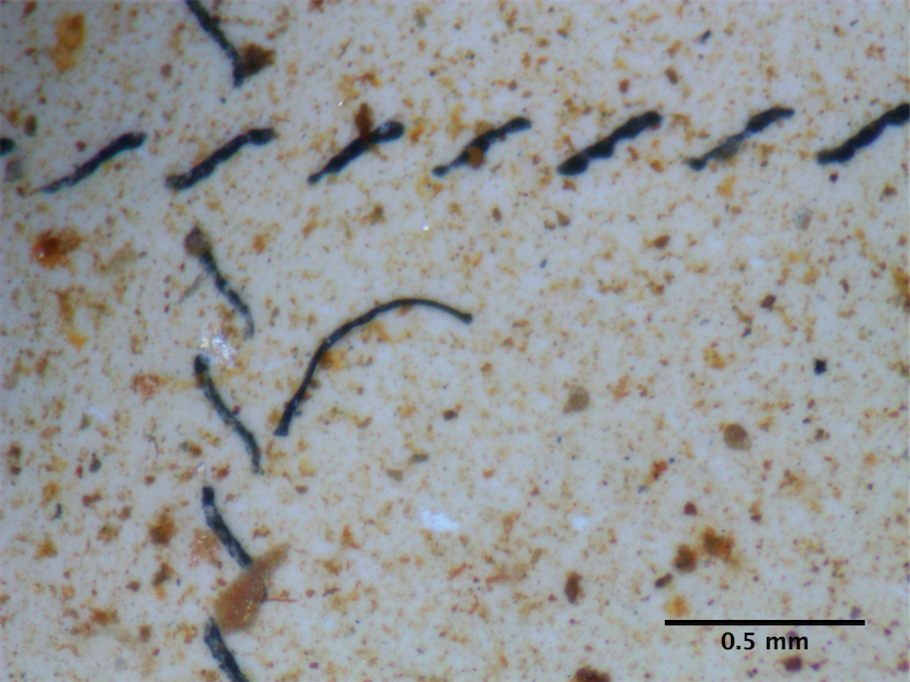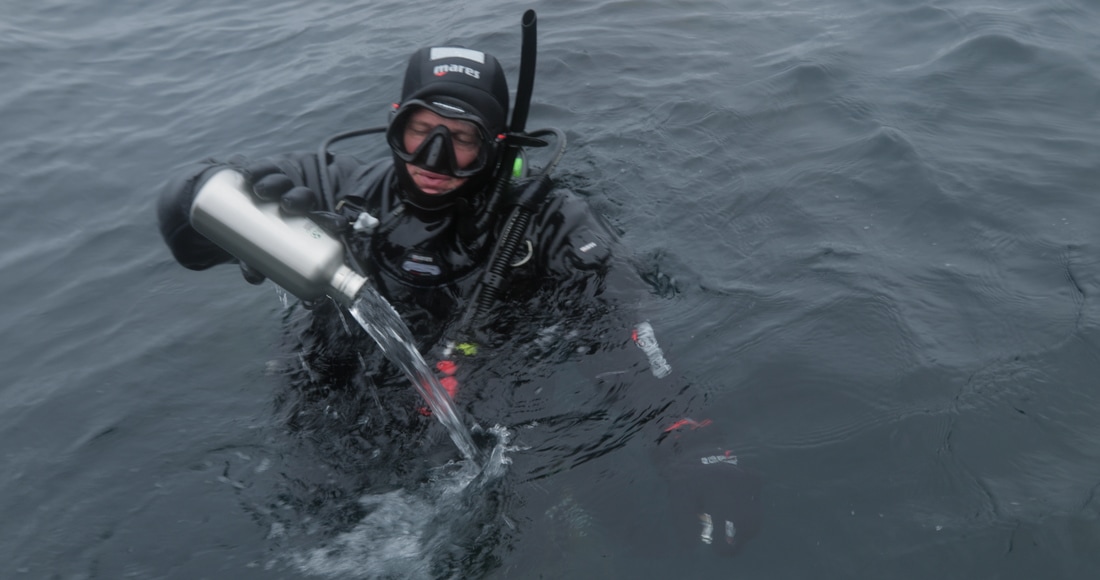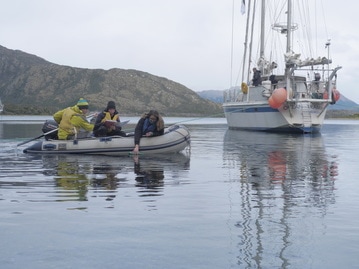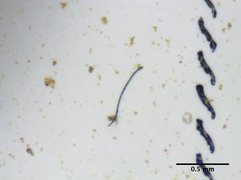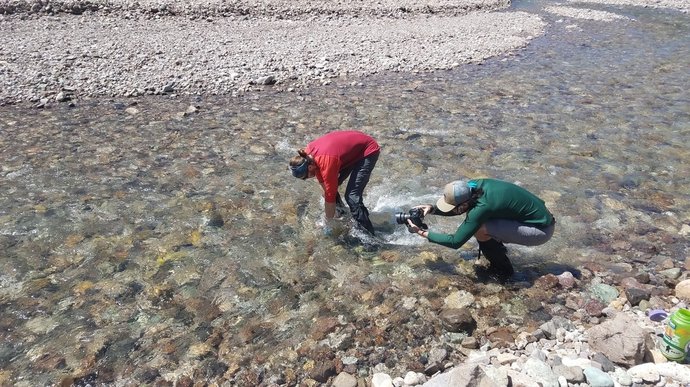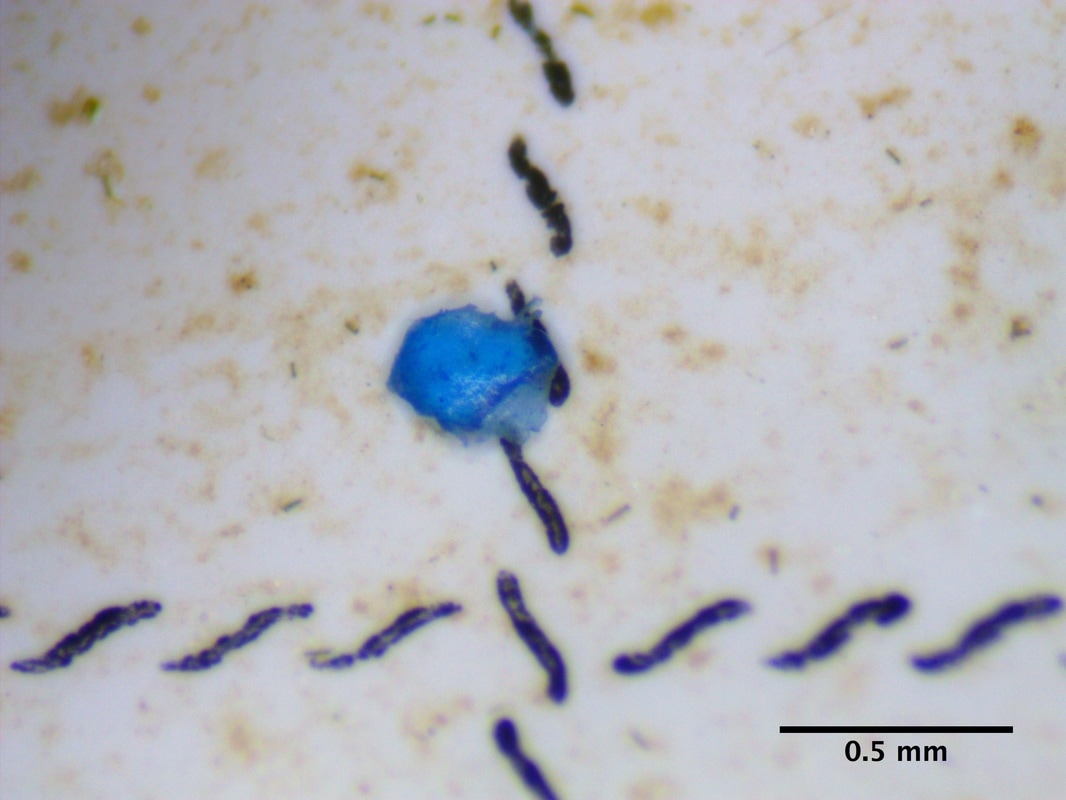Thank you for collecting water samples with the Adventure Scientists’ Global Microplastics Initiative. Your efforts are helping us understand the distribution and concentration of microplastics in the world’s waters, while also building one of the largest microplastics datasets ever. Principal Investigator Abby Barrows has processed your microplastics samples, and we’re excited to share the results of your work!
Lab Process
First, let us briefly explain the process your samples go through in the lab. Once Abby receives your sample, she vacuum pumps each sample over a filter. After the filter has dried, Abby uses a microscope at 45x magnification to look for pieces of microplastic that are less than 5 millimeters. Moving along the grid lines, the filter is systematically counted, with each plastic piece categorized based on shape (round, microfiber, other) and color (blue, red, black, transparent/white, other). The final count for the sample is divided by the sample volume. This calculation helps to standardize the results, as incoming water samples are often not exactly one liter of water.
To date, 1790 of 2410 samples analyzed (74%) contained microplastics. 86% of marine samples contained plastic, while 48% of freshwater samples contained plastic. 24,806 pieces of microplastic have been counted. On average, we are finding about 8 plastic pieces per liter of water. You can check out the number of pieces per liter in each individual sample on the map on our microplastics page.
Note: In the results listed here, we report the total microplastic pieces found in all of your samples. However, for many of our calculations and for the online map, we report the total pieces per liter. As such, your microplastic total on the map may appear different from your total below.
Also, please let us know if your sample isn’t located in the correct place on the map, so that we can fix it for you.
National Geographic Explorer-in-Residence and Adventure Scientists Science Advisory Council member Dr. Enric Sala launched the Pristine Seas project in 2008 to identify, survey, protect, and restore the last truly wild places in the ocean. Through exploration, scientific research, economic and policy analysis, and outreach, Pristine Seas works to establish marine reserves where marine life can thrive—while ensuring that they will be effectively managed for years to come. Pristine Seas has helped protect 4.5 million square kilometers of ocean territory*, and has collected microplastics samples for Adventure Scientists during many of their expeditions. Read more about previous Pristine Seas expeditions on Field Notes.
* Source: National Geographic Society – Pristine Seas
|
Pristine Seas – South Atlantic Ocean
Dr. Jenn Caselle Tristan da Cunha/St. Mary’s School Jenn served as the lead scientist for the National Geographic Pristine Seas trip to Tristan da Cunha, in which she and her team collected water samples for the microplastics project. Jenn is a marine ecologist at the University of California Santa Barbara, where she is a part of the Marine Science Institute and the National Center for Ecological Analysis and Synthesis. Her work focuses on both coral reef and kelp forest ecosystems, studying community dynamics, recruitment and larval dispersal and movement patterns of fishes. She also manages a large-scale field-based monitoring program of kelp forests in the California current ecosystem, with goals of assessing long-term changes due to climate and anthropogenic impacts. On one expedition to Tristan da Cunha, Jenn collected 17 samples, which contained 16 pieces of microplastic: five blue fibers, four clear fibers, and seven black fibers. Jenn also collected two samples from rock pools with students from St. Mary’s School on Tristan da Cunha, which contained one clear microfiber and three black microfibers. |
Pristine Seas – Patagonia
Dr. Alan Friedlander Cape Horn Over the past thirty-five years, Alan has spent nearly 10,000 hours underwater exploring some of the most remote and challenging regions on Earth. He is currently the Chief Scientist for National Geographic’s Pristine Seas Project and the Director of the Fisheries Ecology Research Lab at the University of Hawaii. His scientific publications, numerous popular articles, and documentary films are widely recognized and used for conservation efforts. Alan received his Ph.D. from the University of Hawaii and was a National Research Council Postdoctoral Associate with the Pacific Fisheries Environmental Lab. During his Pristine Seas expedition to Patagonia, Alan collected 17 samples, which contained 19 pieces of microplastic: eight blue microfibers, two red microfibers, six clear microfibers, one black microfiber, one black and clear microfiber, and one blue and clear microfiber. |
Laura Smith
Antarctica
Aboard her ship, Ocean Tramp, Laura collected two samples, which contained 17 pieces of microplastic: eight blue fibers, one red fiber, one clear fiber, four black fibers, one orange fiber, one purple fiber, and one blue fragment.
Laura and her husband, Federico Guerrero, run Quixote Expeditions, a guiding company that sails tourists from Chile’s Cape Horn across Drake Passage to Antarctica. Laura is the expedition leader for Quixote Expeditions and plans all tourist activities during the sailing season. Federico is a longtime sailor and a certified Captain of the ship. When not sailing to Antarctica, Laura and Federico also sail tourists to the Falkland Islands and to Isla de los Estados, in the Argentine portion of Tierra del Fuego. The couple live aboard Ocean Tramp when they’re not leading tours, docking in Ushuaia, Argentina, the so-called “end of the world” on the Tierra del Fuego archipelago.
Dave and Amy Freeman
Minnesota
During their canoeing expedition in the Boundary Waters Canoe Area Wilderness in Northern Minnesota, Dave and Amy collected 23 samples, which contained 28 pieces of microplastic: seven blue fragments, seven clear fibers, six black fibers, six blue fibers, and two clear fragments. Over the last decade Dave and Amy have traveled over 29,000 miles by dogsled, canoe, and kayak through some of the world’s wildest places. They run a nonprofit organization, The Wilderness Classroom, dedicated to teaching students about the world’s wild places. Their series of school assemblies for K-12 students are designed to engage, educate, and entertain students, and they have visited hundreds of schools in the US and Canada.
Dylan Jones and Gabe DeWitt
Chile
During their multi-day trek of Sendero Avilés in Parque Patagonia, Dylan and Gabe collected two samples, which contained one black microfiber. Dylan is a writer and photographer based in the mountains of West Virginia. He has collected data for Adventure Scientists in the American West, Thailand, Costa Rica, and Chile. He is managing editor of Highland Outdoors and a regular contributor to RootsRated. Dylan holds a bachelor’s degree in journalism and a master’s degree in public administration, both from West Virginia University. Dylan has an insatiable appetite for adventures, exploring the Appalachia by rock climbing, mountain biking, backpacking, and snowboarding. Gabe, Dylan’s expedition partner, is a photographer and engineer, also based in West Virginia.
Read about Dylan’s Patagonia adventure in Field Notes, and stay tuned for Part 2, coming soon.
Nature’s Course
Aaron Schye
Montana
Aaron collected 11 samples, which contained one red microfiber, one blue microfiber, and one blue fragment. Aaron is based in Bozeman, Montana, where he collected samples during a few hiking adventures. You can learn more about Aaron’s adventures on his blog, Nature’s Course, aimed at inspiring others to explore and protect wild places.
Project Trends
Though we’re finding an average of 8 pieces per liter for the project overall, there is much more microplastic in marine samples than freshwater samples. The concentration of microplastic in marine samples is over 12 pieces per liter. This is much greater than the concentration in freshwater samples, which is over 1 piece per liter.
Another interesting trend we’re seeing is 90% of the microplastic we’ve counted is fibrous: the pieces are thread-like or line shaped. Finding a majority of these fibers in samples could suggest that microfibers are the primary microplastic input into waterways.
Thanks so much, again, for your dedication to this program and our shared waterways!

